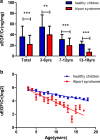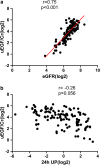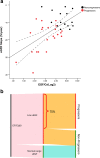Urinary epidermal growth factor as a prognostic marker for the progression of Alport syndrome in children
- PMID: 29948307
- PMCID: PMC6132884
- DOI: 10.1007/s00467-018-3988-1
Urinary epidermal growth factor as a prognostic marker for the progression of Alport syndrome in children
Abstract
Background: Alport syndrome is a rare hereditary kidney disease manifested with progressive renal failure. Considerable variation exists in terms of disease progression among patients with Alport syndrome. Identification of patients at high risk of rapid progression remains an unmet need. Urinary epidermal growth factor (uEGF) has been shown to be independently associated with risk of progression to adverse kidney outcome in multiple independent adult chronic kidney disease (CKD) cohorts. In this study, we aim to assess if uEGF is associated with kidney impairment and its prognostic value for children with Alport syndrome.
Methods: One hundred and seventeen pediatric patients with Alport syndrome and 146 healthy children (3-18 years old) were included in this study. uEGF was measured in duplicates in baseline urine samples using ELISA (R&D) and concentration was normalized by urine creatinine (uEGF/Cr). In patients with longitudinal follow-up data (n = 38), progression was defined as deteriorated kidney function (CKD stage increase) during follow-up period (follow-up length is about 31 months in average). The association of baseline uEGF/Cr level with estimated glomerular filtration rate (eGFR) slope and Alport syndrome patients' progression to a more advanced CKD stage during the follow-up period was used to evaluate the prognostic value of the marker.
Results: We found that uEGF/creatinine (uEGF/Cr) decreases with age in pediatric patients with Alport syndrome with a significantly faster rate than in healthy children of the same age group. uEGF/Cr is significantly correlated with eGFR (r = 0.75, p < 0.001), after adjustment for age. In 38 patients with longitudinal follow-up, we observed a significant correlation between uEGF/Cr and eGFR slope (r = 0.58, p < 0.001). Patients with lower uEGF/Cr level were at increased risk of progression to a higher CKD stage. uEGF/Cr was able to distinguish progressors from non-progressors with an AUC of 0.88, versus 0.77 by eGFR and 0.81 by 24-h urinary protein (24-h UP).
Conclusions: Our study suggests that uEGF/Cr is a promising biomarker for accelerated kidney function decline in pediatric patients with Alport syndrome. It may help to identify patients at high risk of progression for targeted clinical care and improve the patients' stratification in interventional trials.
Keywords: Alport syndrome; Prognostic marker; Progression; Urinary epidermal growth factor (uEGF).
Conflict of interest statement
Conflict of interest
V.N., W.J, and M.K. hold a patent PCT/EP2014/073413 “Biomarkers and methods for progression prediction for chronic kidney disease”. The other authors declared no competing interests.
Ethics
The ethical committee of Peking University First Hospital approved the project and informed consents were obtained from all the subjects and their family members.
Figures





Similar articles
-
Associations of urinary epidermal growth factor and monocyte chemotactic protein-1 with kidney involvement in patients with diabetic kidney disease.Nephrol Dial Transplant. 2020 Feb 1;35(2):291-297. doi: 10.1093/ndt/gfy314. Nephrol Dial Transplant. 2020. PMID: 30357416
-
Low levels of urinary epidermal growth factor predict chronic kidney disease progression in children.Kidney Int. 2019 Jul;96(1):214-221. doi: 10.1016/j.kint.2019.01.035. Epub 2019 Mar 20. Kidney Int. 2019. PMID: 31005273
-
Urinary epidermal growth factor predicts renal prognosis in antineutrophil cytoplasmic antibody-associated vasculitis.Ann Rheum Dis. 2018 Sep;77(9):1339-1344. doi: 10.1136/annrheumdis-2017-212578. Epub 2018 May 3. Ann Rheum Dis. 2018. PMID: 29724728
-
Urinary Epidermal Growth Factor: A Promising "Next Generation" Biomarker in Kidney Disease.Am J Nephrol. 2022;53(5):372-387. doi: 10.1159/000524586. Epub 2022 May 10. Am J Nephrol. 2022. PMID: 35537382 Review.
-
Potential Role and Limitations of Estimated Glomerular Filtration Rate Slope Assessment in Cardiovascular Trials: A Review.JAMA Cardiol. 2022 May 1;7(5):549-555. doi: 10.1001/jamacardio.2021.5151. JAMA Cardiol. 2022. PMID: 34985495 Review.
Cited by
-
Perspectives in systems nephrology.Cell Tissue Res. 2021 Aug;385(2):475-488. doi: 10.1007/s00441-021-03470-3. Epub 2021 May 24. Cell Tissue Res. 2021. PMID: 34027630 Free PMC article. Review.
-
Urinary prostaglandin E2 is a biomarker of early adaptive hyperfiltration in solitary functioning kidney.Prostaglandins Other Lipid Mediat. 2020 Feb;146:106403. doi: 10.1016/j.prostaglandins.2019.106403. Epub 2019 Dec 12. Prostaglandins Other Lipid Mediat. 2020. PMID: 31838197 Free PMC article.
-
Molecular Basis, Diagnostic Challenges and Therapeutic Approaches of Alport Syndrome: A Primer for Clinicians.Int J Mol Sci. 2021 Oct 14;22(20):11063. doi: 10.3390/ijms222011063. Int J Mol Sci. 2021. PMID: 34681722 Free PMC article. Review.
-
Discrepant changes of urinary cystatin C and other urinary biomarkers in preterm neonates.J Pediatr (Rio J). 2021 Sep-Oct;97(5):473-475. doi: 10.1016/j.jped.2021.02.002. Epub 2021 Feb 24. J Pediatr (Rio J). 2021. PMID: 33639089 Free PMC article. No abstract available.
-
Proteomic and metabolomic profiling of urine uncovers immune responses in patients with COVID-19.Cell Rep. 2022 Jan 18;38(3):110271. doi: 10.1016/j.celrep.2021.110271. Epub 2021 Dec 28. Cell Rep. 2022. PMID: 35026155 Free PMC article.
References
Publication types
MeSH terms
Substances
Grants and funding
LinkOut - more resources
Full Text Sources
Other Literature Sources
Medical
Research Materials
Miscellaneous

